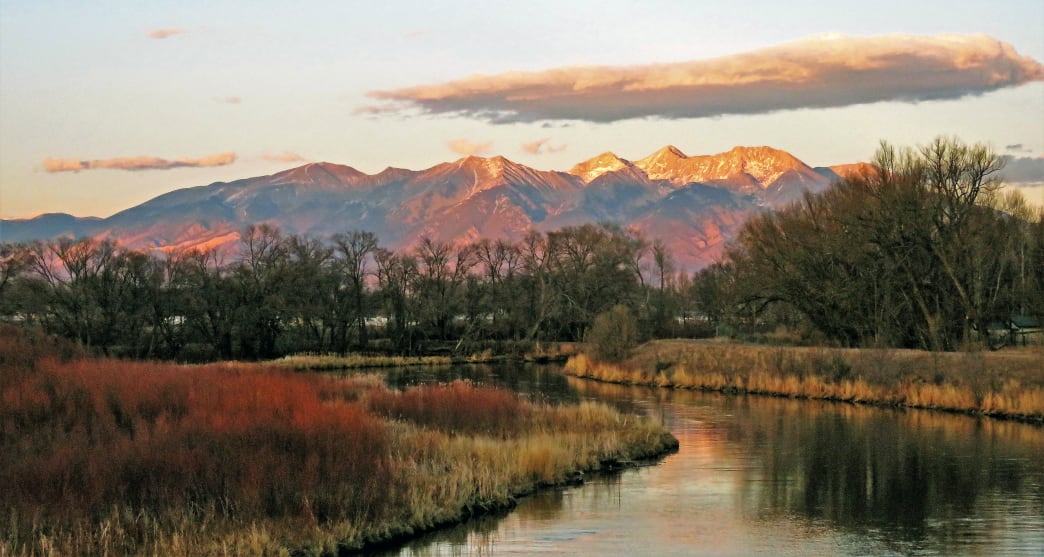When you set foot in Colorado’s San Luis Valley, you enter a landscape unlike any other in the country. Two mountain ranges with 14,000-foot peaks tower over a valley filled with giant sand dunes, rushing rivers and waterfalls, and wetlands teeming with wildlife. Sitting at an elevation of 7,500 feet, the vast valley measures 65 miles wide and 100 miles long. Its size and special blend of natural wonders enable adventures that travelers won’t find in other places. From sandboarding to backpacking among massive dunes, here are 11 epic adventures that celebrate the unique nature of the San Luis Valley.
1. Sandboarding and Sand-sledding
Do you love to skate, surf, snowboard, or sled? If you enjoy cruising on snow or water, try racing down a mountain of sand at Great Sand Dunes National Park and Preserve. Home to the tallest dunes in North America, the park is a popular destination for sand-sledding and sandboarding.
If you’re new to sliding on sand, the National Park Service recommends starting out on the park’s first high ridge of dunes, which has a soft run-out area and is accessible from the main Dunes Parking Area. For the uninitiated, sand-specific boards and sleds feature an extra-slick base material and special wax that enables the devices to slide down dunes. And don’t worry about packing any winter sports gear, cardboard boxes, or plastic saucers: You can rent sleds and boards at a handful of local stores including Kristi Mountain Sports, Sand Dunes Swimming Pool and Recreation, Mountain View Motor Inn, and the Oasis Store.
2. Magnificent Waterfall Hikes
Drive a few miles south of the Great Sand Dunes, and you’ll find a trail that leads to a hidden oasis. Nestled into a ravine on the edge of the Sangre De Cristo Wilderness, Zapata Falls features a 30-foot cascade that pours into a watery ravine.
To reach the falls from Great Sand Dunes National Park and Preserve, drive south on CO-150 and turn east on BLM Road 5415 (the Zapata Falls road). Start your hike at the trailhead for South Zapata Trail #852 and begin hiking uphill, moving farther into the cool, shaded ravine. As you proceed to the falls, you’ll cross a stream and negotiate slippery rocks, so grippy shoes or sandals are ideal. After about a half-mile, you’ll reach Zapata Falls.
3. World-Class Mountain Biking
From the Stone Quarry trails to Penitente Canyon and Bishop’s Rock, the San Luis Valley offers excellent terrain for mountain biking, including segments of slickrock, plus a magnificent backdrop of snow-capped peaks. The trails rival those of the Front Range or Moab, but they see fewer visitors, so there’s a good chance you may be ripping down the trails all by yourself.
In the San Luis Valley, bike trails stretch across South Fork, Del Norte, Alamosa, Antonito, and into Chama, New Mexico. Right in the heart of Alamosa, you can hop on your wheels and link the one-mile Simpson Loop Trail, one-mile Outer Oxbow, 1.2-mile Rio Inspire Trail, and half-mile Inner Oxbow Loop.
For more action, drive west to the Rio Grande National Forest and take BLM Road #5121 to its end point, where there is a trailhead. From here, you can ride several scenic double-track trails, including Nicomodes Gulch (5.1 miles), Bonafacio Gulch South (4.3 miles), and Bonafacio Gulch North (1.6 miles). Plus, you can do a 0.7-mile stretch of singletrack on the Run Rock Roll South trail. As you’re planning your outing and choosing trails to link, be sure to account for the out-and-back mileage.
4. Birdwatching and Wildlife Galore

The Western boundary of the Alamosa National Wildlife Refuge is fed by the Rio Grande River, creating a protected nesting ground and migration touch-down point for a plethora of birds including the Lewis’ woodpecker, willow flycatcher, yellow-billed cuckoo, and the endangered southwestern willow flycatcher. Bird lovers can listen to bird songs, spy various species with binoculars, and capture stunning images, all while keeping their eyes open for other wildlife, including elk and mule deer.
5. Spending the Night Among Majestic Sand Dunes
It’s a camping experience you won’t soon forget: surrounded by towering sand dunes, under a blanket of brilliant stars. And it’s free via a backcountry permit at Great Sand Dunes National Park and Preserve. Permit secured, shoulder your backpack and venture about 1.5 miles into the 30-square-mile dune field near the day use area to stake out your spot. As you camp among the mountains of sand, you’ll enjoy a quiet, peaceful night under a brilliant, starry sky.
Beyond the Great Sand Dunes, you can backpack into the Sangre de Cristo Mountains and camp at South Zapata Lake. In the early 1700s, Spanish explorer Antonio Valverde y Cosio named the snow-capped mountain range for its bright red hue (Sangre de Cristo is Spanish for Blood of Christ). At your campsite, marvel over the stunning backdrop as the lake formes a mirror reflection of a panoramic ridgeline that includes 14,000-foot Ellingwood Point.
To reach the lake, leave from the same trailhead as Zapata Falls. Less than a half-mile up the trail veer right (south) at the kiosk to stay on South Zapata Trail #852. Follow the trail through the tall pines, cross South Zapata Creek, and ascend the steep, rocky trail. As you hike, be sure to look back and enjoy the sweeping views. The singletrack descends to the North Fork South Zapata Creek, where you’ll cross the water via rocks. Follow the trail up to the treeline, traverse over alpine tundra, and then enjoy the stunning reflections in South Zapata Lake.
6. Taking a Dip in the Dunes
Want easy access to the sand dunes for early morning hikes, mid-day swimming, evening sand boarding, and nighttime photography? Great Sand Dunes National Park and Preserve has you covered. Pitch a tent at the Pinon Flats Campground, which is located one mile north of the Visitor Center. Many first-time visitors are amazed by the towering mounds of sand and even more astonished when they see nearby Medano Creek, which forms a natural swimming hole among the dunes. The camping area is open April through October, and water levels in Medano Creek are optimal from May through early June.
Another noteworthy campground located near the dunes is Zapata Falls Campground, which sits at 9,000 feet at the foot of the Sangre de Cristo Mountains. From there, you can soak up the blood-red sunsets and wake up to immediate access to remote trails that deliver exquisite views. Pitch a tent or park your rig for a quiet night at the trailhead of South Zapata Trail. There are toilets but no running water, so you should bring your own or pack a filter to use in South Zapata Creek.
7. Summiting a 14er (or 10)

There’s no other place in the country with such a stark juxtaposition of sky-reaching peaks and sand dunes. The Sangre de Cristo Mountains are home to ten 14,000-foot peaks, and they’re known to be some of the most rugged and revered mountains in Colorado. Summit-baggers can often enjoy their pinnacles in complete solitude, soak up incredible views of high alpine lakes, and then descend into the high-elevation desert to experience a wholly different ecosystem.
The 14ers include Blanca Peak, Crestone Peak, Crestone Needle, Kit Carson Peak, Challenger Point, Humboldt Peak, Culebra Peak, Mt. Lindsey, Ellingwood Point, and Little Bear Peak. Little Bear is one of the most challenging options (Class 4), while Culebra offers one of the easier routes (Class 2).
8. Sipping on Farm-to-Tap Pints
As you sip a Blanca Blonde and gaze across the plains, dunes, and peaks, you’re drinking a craft beer that’s born from the landscape in front of you. The San Luis Valley is known for its long history of producing the raw ingredients for breweries and distilleries across the state. As you ascend a dune or descend a peak, you’re surrounded by fields and farms where the grains are grown, and malt is produced.
At The Colorado Farm Brewery in Alamosa, owners Jason and Josh Cody brew beer made entirely from ingredients grown on their own farm. You’ll also find “farm-to-tap” beer at SquarePeg Brewerks in downtown Alamosa, where friends Derek Heersink and Mark Martinez craft brews using ingredients from local Colorado farms. Next door at San Luis Valley Brewing Company, owners Angie and Scott Graber use locally grown barley and hops to create a spectrum of tasty brews from the dark, rich, and creamy Ol’ 169 Oatmeal Stout to the chili-infused Valle Caliente lager.
9. Chugging Through the Southern Rockies by Train
The Rio Grande Scenic Railroad is considered to have one of the most inspirational views in the country. The La Veta Mountaineer train ride departs from Alamosa in the early morning and spends an entire day climbing into the Southern Rockies. Settle into the cozy confines of a train car and soak up views of the surrounding mountains and wildlife while getting a true taste of the mining history that formed Colorado’s early communities.
10. Hauling in a Giant Trout from Gold Medal Water
There aren’t many places in the country with water as clear as the Rio Grande River, which makes it an angler’s paradise. The waterway starts in the San Juan Mountains, flows into the San Luis Valley, and holds one of the longest segments of Gold Medal Water in the entire state, according to the Colorado Wildlife Commission. Gold Medal Water is a special designation for healthy waterways with cold temperatures that provide a breeding ground for large trout. In these sections of water, at least a dozen high-quality, 14-inch-long trout occupy a given acre.
The Rio Grande flows through the towns of Del Norte, Monte Vista, and Alamosa before continuing south. To find out where the fish are feasting, contact local fishing guides such as the Rio Grande Angler, Wolf Creek Anglers Fly Shop, or Rio Outfitters.
11. Soaking in Historic Hot Springs
The historic Splashland hot springs is natural, simple, and nostalgic: This relaxing spot provides a perfect balance for visitors looking for the option of therapeutic healing waters and fun activities. The geothermal outdoor swimming pool is fed by a 102-degree underground source year-round, and the average temperatures of the pool range from 88 to 96 degrees.
The all-action play area features lap lanes—ideal for stretching out tired muscles after a backpacking trip or mountain bike ride—a diving board, and three water slides for the kiddos (and adults, too). Founded in 1955, this is one of the oldest established hot spring pools in the entire state of Colorado.
When you’re soaking in a hot spring after a day of sandboarding, you’ll be very aware that you’ve come to a special place. With its unique blend of natural features, the San Luis Valley is like no other place in the country. The diverse landscapes are not only beautiful, but make for an outdoor playground with seemingly limitless opportunities for fun. Hoping your next adventure will be unlike anything you’ve experienced before? Then make your way to this unmatched region in Southern Colorado.
Written by Morgan Tilton for Matcha in partnership with Alamosa CVB.







